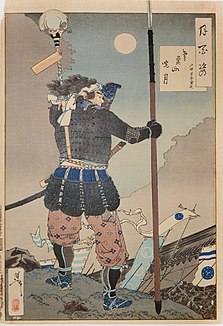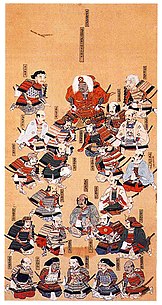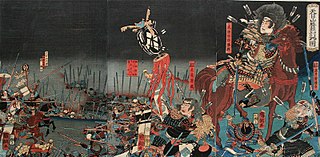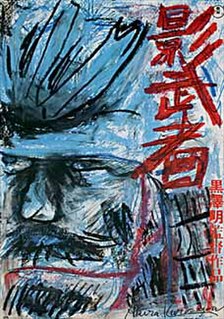
The Battle of Mikatagahara was one of the most famous battles of Takeda Shingen's campaigns, and one of the best demonstrations of his cavalry-based tactics. It was also one of Tokugawa Ieyasu's worst defeats, and complete disaster was only narrowly averted.

The Battle of Nagashino took place in 1575 near Nagashino Castle on the plain of Shitarabara in the Mikawa Province of Japan. Takeda Katsuyori attacked the castle when Okudaira Sadamasa rejoined the Tokugawa, and when his original plot with Oga Yashiro for taking Okazaki Castle, the capital of Mikawa, was discovered.

Nagashino Castle was a Sengoku period Japanese castle located in what is now Shinshiro, eastern Aichi Prefecture, Japan. It is noteworthy as the site of the crucial Battle of Nagashino between the combined forces of Tokugawa Ieyasu and Oda Nobunaga against Takeda Katsuyori in 1575.
The Siege of Noda Castle (野田城の戦い) took place from January to February 1573, between the forces of the Takeda clan, led by the noted warlord Takeda Shingen, against the Tokugawa clan, led by Tokugawa Ieyasu. Along with the Battle of Mikatagahara it was one of the final battles in Takeda Shingen's long career.

Okudaira Nobumasa was a Japanese daimyō of the Sengoku and early Edo periods. Nobumasa's family considered their origins to have been associated with Mikawa Province. The clan was descended through the Akamatsu from the Murakami-Genji.

Anayama Nobutada, also known as Baisetsu Nobutada, was a Japanese samurai. He was the son of Anayama Nobutomo and a nephew of Takeda Shingen. He became famous as one the "Twenty-Four Generals of Takeda Shingen".

The Twenty-Four Generals were just one of many historically famous groupings of battle commanders from Japan's Sengoku Period. These Twenty-Four were the most trusted companions of Takeda Shingen. A third of them died at the famous Battle of Nagashino in 1575 when they led the Takeda forces against Oda Nobunaga. When Takeda Katsuyori committed suicide in 1582, declaring the end of the Takeda clan, only three of them were still serving under the Takeda.

Baba Nobuharu, also known as Baba Nobufusa, was a Japanese samurai of the Sengoku period. He was known as one of the "Twenty-Four Generals of Takeda Shingen".
Naitō Masatoyo also known as Naitō Masahide was a Japanese samurai of the Sengoku period. He was known as one of the "Twenty-Four Generals of Takeda Shingen". Masatoyo was the second son of Takeda Nobutora's senior retainer, Kudō Toratoyo. He was first called Kudō Sukenaga. The family's fortunes fell when Toratoyo lost favor with Nobutora and was killed by him.

Yamagata Masakage was a Japanese samurai warrior of the Sengoku period. He is known as one of the "Twenty-Four Generals of Takeda Shingen". He was famous for his red armour and skill in battlefield, and was a personal friend of Takeda Shingen. He was the younger brother of Obu Toramasa who was also a retainer of Shingen leading the famous "red fire unit". After his brother committed Seppuku as a cover for Takeda Yoshinobu's failed rebellion, Masakage took the red fire unit title and outfitted his cavalry in bright red armor. It was said that his cavalry would always charge first in battle; sowing confusion and panic in the enemy ranks.
Futamata fortress was Takeda Shingen's first objective in his campaign against Tokugawa Ieyasu. In 1572 he left the siege of Futamata in the hands of his son and heir Takeda Katsuyori.

The 1582 Battle of Tenmokuzan in Japan, also known as the Battle of Toriibata, is regarded as the last stand of the Takeda clan. This was the final attempt by Takeda Katsuyori to resist the combined forces of Tokugawa Ieyasu and Oda Nobunaga, who had been campaigning against him for some time.
The second siege of Takatenjin came only six years after Takeda Katsuyori took the fortress.
The first siege of Takatenjin occurred in 1574, when it was attacked by the forces of Takeda Katsuyori. The garrison was commanded by Ogasawara Nagatada, who held the fortress for Tokugawa Ieyasu.
The 1575 Siege of Yoshida Castle was undertaken by Takeda Katsuyori against the forces of Tokugawa Ieyasu during the Sengoku Period of Japanese history. This would be one of many battles fought by the Tokugawa and Takeda samurai clans during Japan's Sengoku period (1467-1603).
The 1580 battle of Omosu was one of many battles fought between the Hōjō and Takeda clans during Japan's Sengoku period. It is distinguished, however, as one of the very few naval battles to be fought in pre-modern Japan.
The 1582 siege of Takatō (高遠城の戦い) was one of the final battles of the Takeda clan against the forces of Oda Nobunaga and Tokugawa Ieyasu.
Takeda Nobuzane (武田信実) more commonly known as Kawakubo Nobuzane was a younger half-brother of Takeda Shingen, a preeminent daimyō who vied for the control of Japan in the late stage of Sengoku, the "warring states" period. He was also called Kawakubo Nobuzane because he was raised in Kawakubo village.
Shinpu Castle, or Shimpu-jo, was a hilltop type castle, originally constructed in 1581. The original castle was built in the area by Takeda Katsuyori, who built it to defend his territory in the area from the threatening forces of Oda Nobunaga and Tokugawa Ieyasu. He was forced to burn it and flee when Ieyasu attacked northwards in 1582. Takeda committed suicide after suffering a defeat from the forces of the combined clans at Battle of Tenmokuzan.












